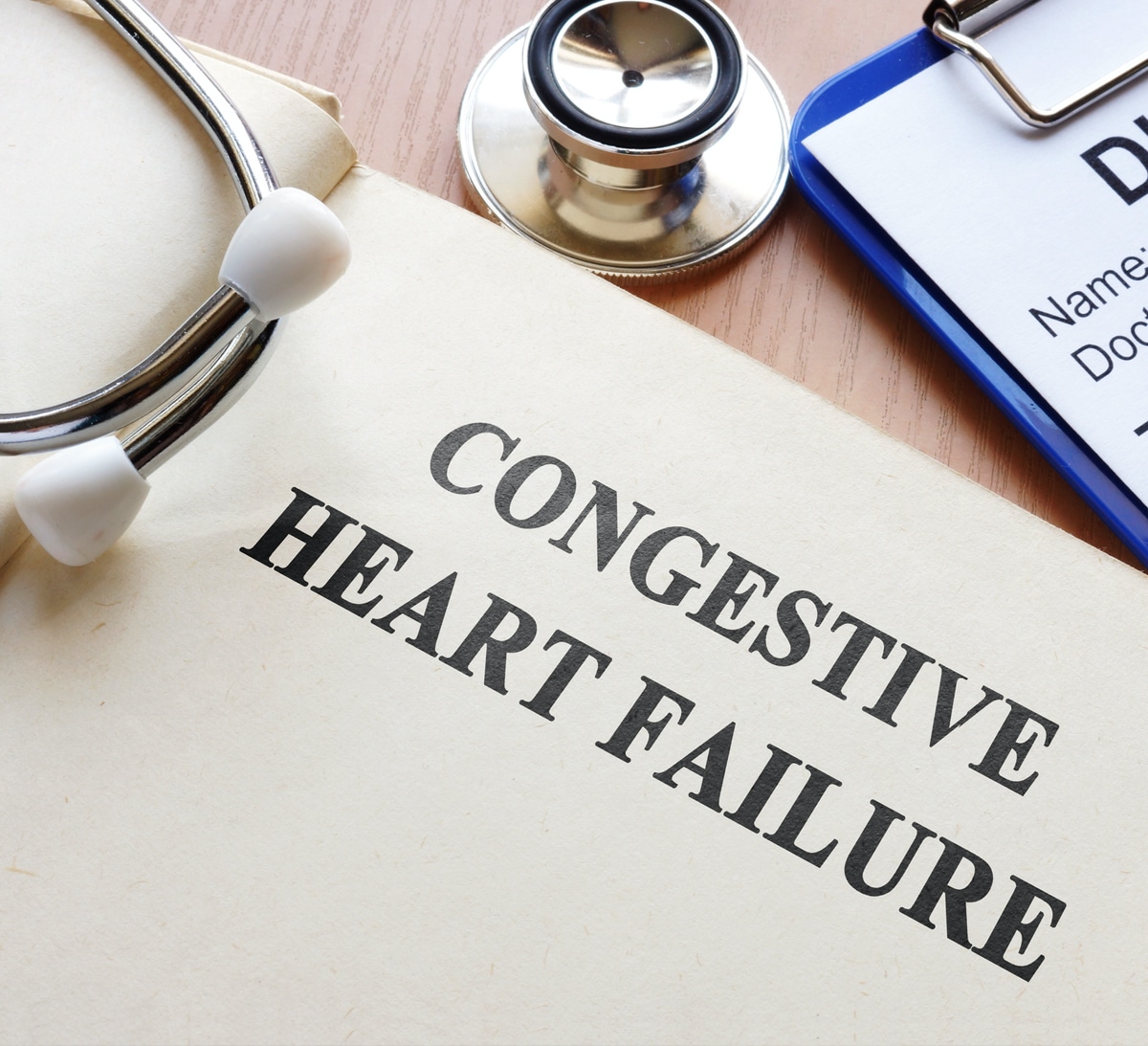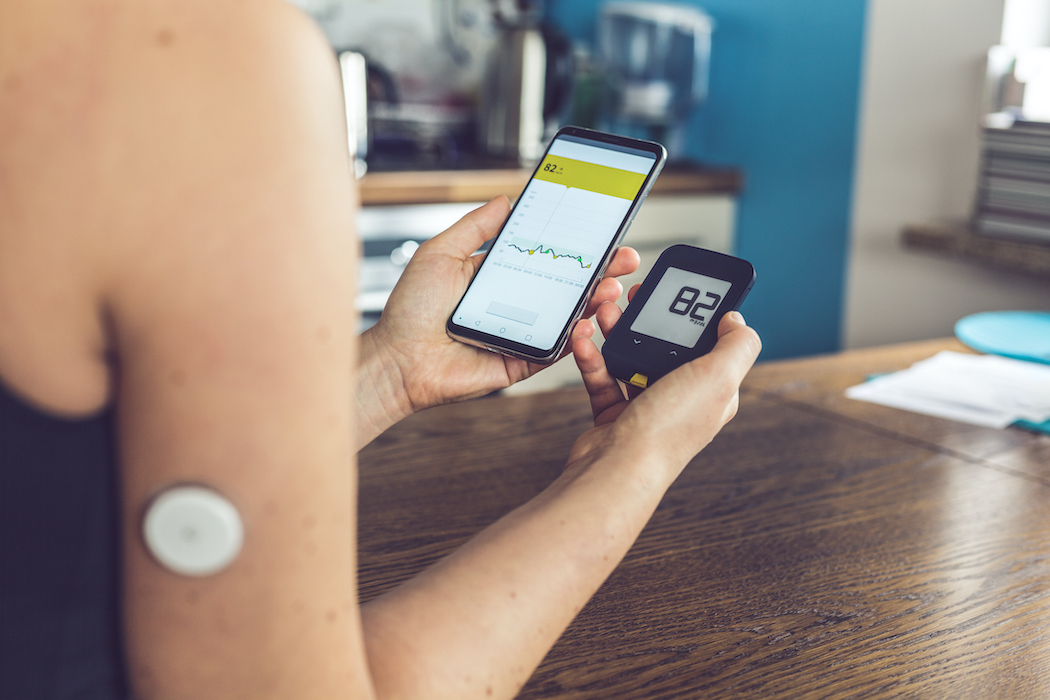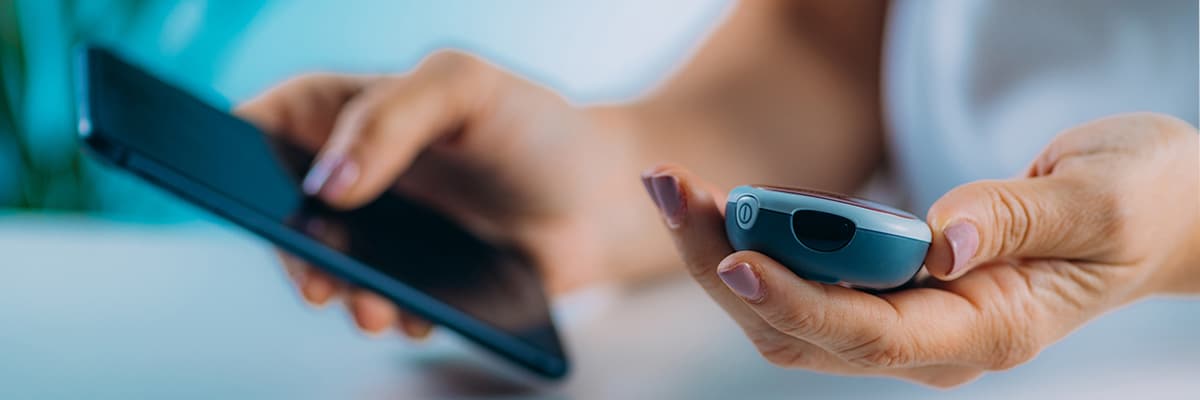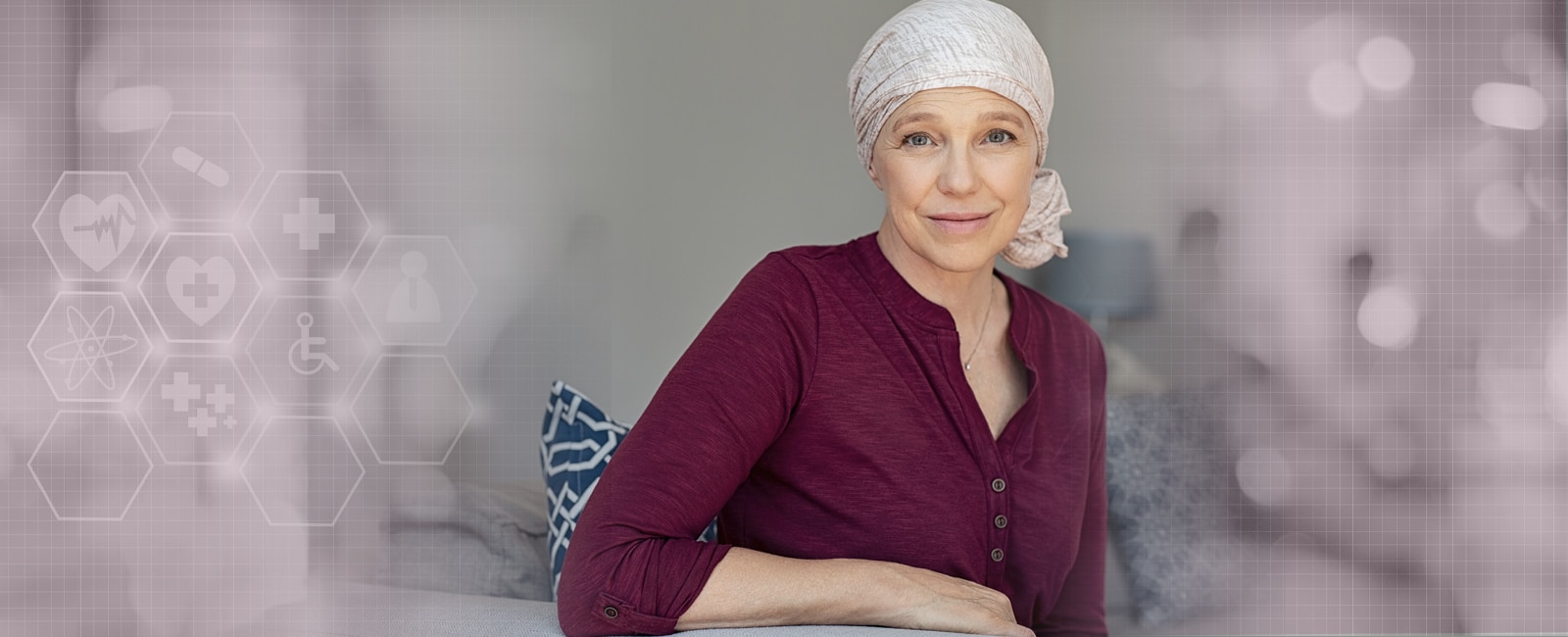What is remote patient monitoring?
Remote patient monitoring, commonly referred to by its acronym RPM, is the process of gathering patient generated health data from wearable remote monitoring devices and sending those biometrics to healthcare professionals in real time. Physicians are able to review analytics and provide suggestions to patients to help them reach their personal health goals. To better understand how remote patient monitoring could increase revenue for your practice while simultaneously improving patient outcomes, continue reading.
by Jessica Elliot
Remote Patient Monitoring | RPM Benefits
Need to decide what we want here if anything
Table of Contents:
- Increased Viability of RPM Reimbursement
- What You Need to Know: Final 2021 CMS RPM Guidelines
- RPM: Lowering Hospital Readmissions, Improving Outcomes
- RPM – The Right Tool for COVID-19 and Beyond
- Wearables and Virtual Care: Engaging Patients, Improving Outcomes
- Healthcare and its Consumers:3 Reasons Patients Take Charge in 2021
- Overview of the 2022 Physician Fee Schedule Final Rule
Increased Viability of RPM Reimbursement
As the nation’s healthcare costs continue to rise, Remote Patient Monitoring (RPM) has increasingly been used as a viable solution for managing patients with both chronic and acute conditions. Also sometimes referred to as Remote Physiologic Monitoring (RPM), is defined by the Center for Medicare & Medicaid Services as “the collection of physiologic data (for example ECG, blood pressure, glucose monitoring) digitally stores or transmitted by the patient or caregiver or both to the home health agency.” The uptake and movement towards different telemedicine solutions has been catalyzed by the pandemic, and many providers are discovering that RPM provides a valuable opportunity for providers and patients alike.
Using DocsInk’s Remote Patient Monitoring platform, a single-provider practice was able to onboard 200 patients in 90 days, resulting in an increase in revenue of $50,000. Because DocsInk’s platform is built for efficiency and ease of use, the adoption and implementation of this RPM program did not require the practice to hire any additional full-time employees. Not only was the program profitable, more importantly it was effective in producing patient outcomes. The patients onboarded to this program were 93% compliant, indicating that DocsInk’s Remote Patient Monitoring solution is a powerful tool in recruiting patients to take an active role in the management of their conditions. DocsInk’s program effectively engages the patient in an engagement feedback loop, fostering outcomes for patients and providers.
What You Need to Know: Final 2021 CMS RPM Guidelines

We’ve done the hardwork so you don’t have to.
On December 1, 2020, the Centers for Medicare and Medicaid Services (CMS) and Health and Human Services (HHS) issued a Final Rule which went into effect January 1, 2021. The Rule published in the Federal Register on 12/28/20, includes changes to the 2021 Physicians Fee Schedule (PFS), various payment policy updates and finalized provisions of the interim final rules which were issued in 2020 and related to the Public Health Emergency (PHE) and COVID-19.
This 2021 CMS Ruling contains critical updates to codes, especially for Remote Patient Monitoring which we have formatted into a short pdf just for you.
We read every page and brought the key elements down to five pages. If you’re concerned about how the CMS ruling will impact RPM in your practice, click here to read on… we’ve done the hard work for you.
Final 2021 CMS RPM Guidelines
General Guidelines
During the pandemic, a physician may order RPM for both new and established patients. Post-pandemic, RPM may only be ordered for established patients, requiring a prior visit with the billing provider either in person or via telehealth.
Patients must consent to receive RPM services, but consent may be obtained at the time that RPM services are first furnished rather than ahead of time.
RPM may be ordered for patients with either chronic OR acute conditions. RPM codes….read full overview
RPM: Lowering Hospital Readmissions, Improving Outcomes

Hospital readmissions are a dreadful reality for faculty and patients alike. Remote Patient Monitoring is a viable solution for both.
Adverse effects for hospitals include enormous costs. Costs estimated to be in the vicinity of $26 billion annually. Operations suffer and HCAHP scores fall.
The negative effect on patients is also noticed. The undue stress and frustration may make them feel as their health issues are unmanageable.
There is hope, however. Research has demonstrated that the use of Remote Patient Monitoring (RPM) can positively impact both hospitals’ concerns and the patients’ worry.
Although the effect of readmissions on hospitals is widespread, the populations experiencing readmission most are chronic and acute care patients. The top two of these chronic conditions are congestive heart failure (CHF) and diabetes. For these chronic conditions, remote patient monitoring reduces readmissions and generates recurring revenue. It has also has proven to increase health outcomes in those patients with CHF and diabetes.
Impact on CHF
Congestive heart failure is the leading cause of death in the United States. According to the CDC, one person dies every 36 seconds in the U.S. from cardiovascular disease. Progress in fighting the disease, however, improves annually with better medications, use of wireless sensors, and advances in sleep apnea treatment. Yet still, readmittance in this population is staggering. One in every five patients is readmitted within the first 30 days of discharge with a median readmission time of 12 days from initial discharge.
Readmission is expensive. The national mean cost of a CHF admission per year is $34,000 with an average 30-day, 60-day and 90-day readmission rate of 22.3%, 33.3% and 40.2% respectively. According to the American Heart Association, the costs of CHF readmissions continue to rise, at a current average of $13,500.
What is being done to help lower readmissions for heart patients?
Improvements in the management of Medicare beneficiaries, prior to and after initial hospitalization for CHF. This alone has the potential to prevent hospital readmissions. Not only are there cost savings, but persons living with this chronic condition see big benefits as well.
Secondly, we’re seeing more proof that RPM could be the key. The National Library of Medicine includes a study that demonstrates how RPM directly reduces mortality, hospitalizations, and improves quality of life for CHF patients.
By remotely monitoring blood pressure, heart rate, weight and ECG, health plans such as Geisinger have effectively managed patients with heart failure. Since 2008, Geisinger Health Plan has used RPM to reduce the risk of all-cause readmission for their Medicare Advantage members by 77%.
Geisinger is not alone. Similar studies demonstrate that when RPM is used to treat cardiac patients, readmissions related to heart failure are reduced by 64%. In turn, that results in a net savings of $5,034 per patient, per year when compared to standard care without RPM.
Impact on Diabetics
Diabetes is another leading chronic condition. In fact, more than 34 million Americans had diabetes as recently as 2018, according to the CDC. It’s an expensive illness, for those with diabetes incur average medical expenses of $16,752, roughly 2.3 times higher than those incurred by patients without diabetes.


Diabetes impacts Americans of all backgrounds, all ages. Veterans seem to suffer from it in larger numbers with a quarter of all veterans having diabetes. This led the Veterans Health Administration (VHA) to conduct a study on diabetic veterans, each of whom had two or more prior hospitalizations or ER visits.
The VHA found when RPM was used for one year re-hospitalizations were reduced by 50% and emergency room visits were down 11%. Additionally, the average number of bed days were three days shorter. And finally, 95% of these veterans reported a high patient satisfaction rate with the RPM program. Satisfaction drives usage, and therefore ongoing health benefits can be expected.
Of course, it’s not just the VA that is looking to determine the efficacy of RPM programs. Comparison studies have been conducted by many other independent researchers, and the results are encouraging. Those using RPM saw a 77.2% improvement in their health, versus only 70.4% improvement in stability for those not using RPM solutions.
Benefits: Clinical and Fiscal
Based on the results of the above-mentioned research, patients benefit greatly from use of remote patient monitoring solutions. And of course, we have noted the benefits that hospitals and physician groups see. But there is also great benefit to insurance payers.
The Coalition to Transform Advanced Care (CTAC) and America’s Health Insurance Plans (AHIP) published an article which cites several studies. Each of these reported positive clinical and fiscal benefits of RPM programs.
Patients in RPM programs reported significantly fewer care requests:
- 51% fewer on-call urgent visits
- 47% fewer physician visits
- 41% fewer phone calls related to patient care
- 40% reduction in hospitalization of senior citizens
- Medicare members are 76% less likely to experience hospital readmissions when using RPM
- 94 – 97% of patients noted their satisfaction with the RPM programs.

RPM – The Right Tool for COVID-19 and Beyond (WHY IS IT BLUE? MAKE IT MATCH OTHER HEADERS)

Remote physiologic monitoring (RPM) technology, also called remote patient monitoring, is playing a vital role during the current pandemic. It excels in connecting patients to care teams, providing real-time clinical data needed to control symptom and disease progression. As COVID-19 continues to spread, our country faces the unprecedented challenge of managing health in a safe and effective manner.
Time and resources are valuable commodities for all healthcare organizations — especially as medical professionals battle this pandemic. Clinicians adopt RPM to monitor, assess and address patients’ health, instantly receiving vitals and data from thermometers, pulse oximeters and blood pressure monitors. With real-time insights come fast response, better prioritization and triage of patients, and faster delivery of healthcare when every minute counts.
Patients no longer have to rely on their own discretion as to whether their rising temperature or shortness of breath warrant a visit to the nearest emergency room. With RPM technologies, they have confidence that they are being monitored; a change in their health status will be immediately conveyed to their care team. RPM expedites the delivery of medical care in a safe and virtual manner, as face-to-face treatment now poses too large of a risk potential in many cases. The Centers for Medicare and Medicaid Services (CMS) recently released new regulations covering these services for patients with acute conditions.
CPT Codes and RPM Adoption
The recent healthcare crisis put a spotlight on the value of tools like RPM and wearable devices in the management of patient outcomes. It was in 2019, however, that their use became more common. That is when CMS published several new RPM Current Procedural Terminology (CPT) codes. These CPT codes more clearly improve reimbursement for the work typically performed around RPM service programs. This includes issuing devices to the patient and training them on its use. It also supports electronic transmissions, monitoring clinical data, and interactively communicating with patients.
These newly released codes successfully boosted physician adoption. In Spyglass Consulting Group’s 2019 survey, 88% of healthcare providers reported either purchasing or evaluating RPM technologies. Providers have found RPM valuable in managing high-risk populations. It also led to expansion of chronic care management programs, aiding in the successful transition to value-based care models. RPM is highly effective in treating prevalent diseases, such as diabetes, congestive heart failure, hypertension, chronic obstructive pulmonary disease, and asthma. Studies demonstrate that they play a significant role in substantially reducing readmission rates and overall costs of care.
In 2020, CMS further relaxed their RPM guidelines. Clinical staff can now perform these services under the supervising physician’s general supervision based on CMS’ incident-to guidelines. This allows care providers to work efficiently, freeing up physician time for more complex treatments and procedures. It also expands the potential business models for RPM programs, as the physician doesn’t have to be in the same physical location while the services are performed.
Medical Benefits of RPM
DocsInk uniquely positions medical professionals to successfully implement an RPM program. It simplifies the day to day use of remote patient monitoring for medical professionals by seamlessly connecting to any wearable device. Additionally, it offers customizable clinical alert notifications, facilitates templated patient surveys, streamlines interactive patient communications, and instantly bills for all professional services rendered.
We are all working to gain control over the global health crisis. Yet we must simultaneously navigate value-based care, manage chronically-ill patient populations, and provide general health coaching. That’s why we created a new solution. DocsInk’s RPM solution offers a strong ROI, improved workflow efficiencies, and the tools to achieve patient goals.
Wearables and Virtual Care: Engaging Patients, Improving Outcomes

When Congress passed its 2018 bill expanding Medicare coverage to include telehealth and remote patient monitoring (RPM), options for delivery of patient care expanded. The government and insurance approval set the stage: clinicians could now offer virtual care via RPM and telehealth. It was officially a viable, safe, and effective alternative to traditional services and wearable technology is at the forefront of this healthcare industry change.
The onset of the COVID-19 pandemic early in 2020 further spurred adoption of RPM and telehealth. It became the primary solution for delivering care outside typical brick and mortar offices. Telehealth became the answer to the question: how can we protect the health of our nation’s population?
With government, insurance, and patients on board, we are well on our way to widespread implementation of these technologies. A 2019 study conducted by the Consumer Technology Association (CTA) found that 68% of physicians strongly intended to use RPM. Now is the time for the remaining 32% to fully understand the positive impact that remote access to real-time data can have, specifically as it pertains to overall wellness, behavior change, and the treatment of both acute and chronic illnesses.
Consumers Like Wearable Technologies – Apple Health. Google Fit. Samsung Health.
While wearables come from many brands and in many forms, most people rely on at least one of these platforms to help them interpret the data their digital coach offers. More than one in four Americans currently use at least one wearable device. According to IDC, wrist-worn wearables are projected to increase to 105.3 million units by 2023.
These growing numbers demonstrate that consumers increasingly have a keen interest in taking some level of personal responsibility for their health. Clinicians have found that patient engagement is a critical component in meeting clinical goals and improved health outcomes.
According to the World Health Organization, 60% of factors related to individual health and quality of life are correlated to lifestyle choices. When medical professionals take advantage of technologies already adopted by their patients, they encourage positive habits and provide the feedback necessary for best results.
The combination of wearable devices and doctor/patient engagement has numerous benefits, including:
- Correctly taking prescriptions
- Getting enough exercise
- Reducing stress
If people, then, are interested in being more involved, how can physicians better leverage this opportunity? How can they encourage these benefits for patients who are high risk due to acute or chronic illness?
It’s become a simple answer: incorporate RPM to promote proactive medical care, accessing real-time data and intervening when necessary, based on changes/declines in patient’s vitals and other physiologic metrics.
Impacting Crucial Metrics
Remote patient monitoring (RPM) is shown to impact numerous factors, from curtailing recurrent rehospitalizations to better patient/provider care coordination. The holy grail, of course, is improving patient outcomes and reducing costs of care, while balancing workflow efficiency. All this can happen with the application of affordable RPM and telehealth technology.

- Outpatient services is easily expanded. This is good news for all, but especially for underserved populations and patients in rural areas.
- Reducing hospitalizations and hospital stays is one of the biggest demonstrable effects. A University of Pittsburgh study from 2020 indicated a 76% reduction in readmissions when RPM is utilized.
- Improved patient outcomes are seen in more than 49% of those using this technology to manage health, according to the University of Pittsburgh study.
- Reduced costs of care are reported by many independent studies, which specifically show a net savings of over $5k per patient per year for cardiac patients.
- Improved compliance is near the top of the list of benefits for both critically and chronically ill patients. Clinical goals are met and conditions improve.
- Patients more engaged in their health tend to remain healthier. Patient knowledge can result in fewer invasive procedures, fewer missed appointments, and authentic discussions on care options – all of which lead to better clinical outcomes.
Make It Easy To Implement, Easier To Measure
As with all science, measurement is the only way to improve. But it’s more than having a watch that tells you things about your health. Patients benefit from clinicians who can connect with them about their daily wellness monitoring. They also benefit from the capability to pair with medical devices which leads to disease management and recovery. The key is to simplify the implementation for both physicians and patients.
A recent addition to the DocsInk platform for example, provides the ability for clinicians to sync with over 200 wearables. This kind of accessibility takes the pressure off caregivers and office managers. It also aligns the devices patients have already invested in with the platform used in the office. Giving patients the flexibility to use the device of their choice makes them more likely to remain engaged in its use.
In addition, when clinicians need to write an order for specific RPM devices to manage disease process(es), DocsInk connects to countless wearable devices to provide real-time data, notifications and alerts to promote best outcomes.
Many physicians have historically been concerned about what to do with all this data. How do they begin to sort through all the information to get to insights about the direction of patients’ health? DocsInk research found the best approach is to customize the information being analyzed. Then, deliver only the specific information requested back to each clinician. That data then alerts the appropriate clinical team member to initiate patient touch points and interventions.
While devices can monitor everything from respiratory rate, oxygen levels, pulse, blood pressure, body temperature and more, we understand that every patient and each provider that cares for them are different. That’s where DocsInk shines.

Now Is The Right Time
When the pharmaceutical industry began its meteoric rise in the 1950s and 1960s, the populations began searching for the next pill that would make them feel better. Today’s patient relies on technology more than pills as they proactively participate in their own health.
This monumental shift in how consumers approach health management results in an entirely new class of healthcare consumers who expect to be able to solve care problems without an in-person appointment. Patients, now more than ever, look for the option of remote care as they choose their medical providers.
Now is the time to take advantage of new approaches. Advancements in this field had been on the sensor technology in consumer products, but now there are technologies that provide improved ROI for the medical industry, in addition to providing better patient care.
Now is the time to implement RPM. The groundwork is laid with more than 284 million internet users in the USA – and that climbs daily with pandemic-inspired rural broadband implementation. Factors like global physician shortages and the evolving healthcare policy landscape should inspire pursuit
Healthcare and its Consumers: 3 Reasons Patients Take Charge in 2021

Healthcare Consumerism.
It’s a term representing a time that has finally come.
Thanks in large part to the impacts of the pandemic, the world of patient care has been upended. While COVID-19 has caused big changes in all industries, healthcare is certainly near the top of the list.
As a result, patients are more empowered.
According to Patient Engagement HIT, almost 2/3 (64%) of patients are expected to change healthcare providers if their current provider fails to meet their expectations. That is a big number, and it will have a big impact on the business side of your practice. How so?
Firstly, physician shopping has become pervasive. As medical practices market more, patients become savvier themselves and learn that it is easy to find a new provider.
Secondly, there’s a trend toward ease of navigation. Users expect onboarding to be simple, and the tools to be adaptable. Patients that can’t easily connect with their provider are likely to look for a new one.
And finally, today’s tech-savvy patients are aware that the healthcare industry is capable of facilitating a better, more user-friendly experience. Subsequently, they expect more from practitioners.
What Patients Want
Distancing and unnecessary contact is not something unique to 2020 but will follow us into 2021. Patients have learned to depend more on technology and less on wheels for just about everything. They’ve become familiar with remote care and prefer telehealth whenever it is a reasonable option.
To address patient retention, here are three things healthcare consumers are looking for:
- Control Over Their Time
For decades, patients have expressed frustration over the difficulty of obtaining a medical appointment. Once made, patients on average show up on time – due to numerous possibilities, the physician often doesn’t, and the waiting game begins.
Their demand? No more anxiety and frustration over waiting an hour or more in a doctor’s office just to be seen. Not anymore.
In fact, many are wishing away the waiting room entirely. The idea of sitting in a room full of sick people for an extended stretch of time is outdated in part thanks to virtual waiting rooms.
They make the process significantly more efficient and comfortable for patients. This particular feature of the DocsInk platform has been met with applause from both patient and practitioner. Automated check-ins can be customized for better doctor-patient process alignment resulting in better time management, and higher scores on patient satisfaction surveys.

- Virtual Expectations
Between January and June of 2020, telemedicine visits rose by 2000%.
You read that right. Not 200%, but 2000%. The doctor-patient experience has been revolutionized.
According to Harvard Business Review, telemedicine is highly effective for younger, digitally savvy patients. However, seniors and the frail often struggle to use the technology.
It is incumbent upon the healthcare provider to determine the level of success each patient can have with different types of remote patient monitoring and telehealth solutions.
While Google Meet and Zoom are second nature to many, some physicians’ groups found that a secure telehealth platform built for the healthcare industry, such as DocsInk’s, is better suited to those hesitant to use technology.

- Better Communication, Improved Continuity of Care
Chronic disease management has taken a turn. While remote patient monitoring (RPM) has been in place for several years, the standardization of telehealth has pushed those with chronic conditions to expect more access to physicians when needed.
Utilization of RPM in situations such as this is only logical. Consider the enormous cost of high-acuity healthcare encounters for patient, payer and provider. Yet also consider the higher cost of not getting care. A recent survey found 10% of respondents were so worried about the impact of the pandemic that they would forego care altogether. This is where telehealth offers control over environment—not having to be in public—and subsequently improves health outcomes.
Yet, beyond online appointments, there’s a new expectation of access that comes out of texting and instant messaging. This is one more way that DocsInk’s platform shines, as it makes it simple for patient or provider to message in real-time. Sudden onset of sharp pain may once have sent patients to the ER. Now, however, they can start by engaging in real-time messaging with the practice and perhaps forego this costly experience, avoiding hospital readmittance fees and improving health outcomes.
The New Era of Healthcare
The public recognizes this is a new era of healthcare. COVID-19, while still rampant and frightening, has instituted a number of positive cultural changes. Patients are more willing to be accountable for their own health, and this often means spending less time in a physician’s office. Practices that embrace this new world are the practices that will succeed.
If you’re still searching for a better way to serve and retain your patients, let’s talk. DocsInk may be the solution you’re looking for.
Overview of the 2022 Physician Fee Schedule Final Rule (WHY IS THIS BLUE)
In January, CMS released the 2022 Physician Fee Schedule Final Rule. This contains important information about how your care management services will be valued and reimbursed in 2022. The overview is dense – over 1,000 pages. But don’t worry! DocsInk has taken the time to identify key trends and changes that you need to know about. Not only did we make an abridged version….we made an abridged abridged version
To download DocsInk’s complete 2022 Physician Fee Schedule Final Rule – click here.
In the meantime, here’s short and skinny:
Finalized Conversion Factor
Centers for Medicare and Medicaid Services’ (CMS) 2022 conversion factor1 has been set at $34.60.
What does this mean for your care management service?
It depends on the type of care management service you provide:
Chronic Care Management (CCM):
- CMS has adopted the American Medical Association’s (AMA) RVU2 Update Committee’s (RUC) recommendation to increase RVU for CCM services to better reflect the value of time spent providing CCM services.
- As a result, the reimbursement for CCM services has increased in 2022.
Remote Physiologic Monitoring (RPM):
- There are minimal reimbursement rate adjustments to RPM services based on both slight reductions to RVUs and the conversion factor rate.
- Based on the conversion factor listed above, the decline in reimbursement will be marginal compared to 2021 rates.
Source for RVU definition: https://www.aapc.com/practice-management/rvus.aspx
Chronic Care Management
- CMS added 1 new CCM CPT code, 99437 , which is an add-on code to the existing 99491 code. They also updated a requirement of beneficiary consent.
Chronic care management services, provided personally by physician or other qualified healthcare professional (QHP), each additional 30 minutes per calendar month with the following required elements:
- Multiple (two or more) chronic conditions expected to last 12 months, or until the death of the patient.
- Chronic conditions place the patient at significant risk of death, acute exacerbation/decompensation, or functional decline.
- Comprehensive care plan established.
What is an add-on code?
Since 99437 is classified as an “add-on” code, it may only be billed in conjunction with CPT code 99491, and it follows the same billing requirements as 99491.
- One of these requirements is that the care management services must be performed personally by a physician or other qualified healthcare professional (QHP).
This is where a gray-area appears in the CMS Final Rule:
- In CMS’s final rule, CPT Code 99437 “describes CCM services furnished by clinical staff under the supervision of a physician or NPP who can bill E/M services and CCM services personally furnished by a physician or NPP.”
- This is in direct contradiction to the AMA’s CPT codebook for 99437 CPT code, which specifies that the code can only be performed by a physician or QHP3.
So, what should I do? DocsInk recommends that you err on the side of caution, and only bill for 99437 when the care management service is performed by the physician for QPH in order to avoid being audited.
Beneficiary Consent
During the Public Health Emergency (PHE) CMS allows beneficiary consent to be obtained by auxiliary staff under general supervision, meaning the staff can be remote from the billing provider4. Previously, CMS required that beneficiary consent be obtained directly from the billing provider or by staff working directly under their supervision.
Telehealth
Category 3 Codes
In 2021, CMS created a list of Category 35 codes to describe the telehealth visits which will be covered temporarily during the COVID-19 PHE. The 2022 Final Rule extends the reimbursement of the Category 3 telehealth codes throughout the last day of 20236, giving CMS time to evaluate which telehealth visit codes meet the requirement for permanent coverage beyond 2023.
Allowances for Geographic Restrictions and Originating Sites
During the PHE, waivers were granted under section 1135 of the Social Security Act and the CARES Act, giving CMS the authority to waive geographic origination requirements for the duration of the PHE7. To continue these site allowances beyond the PHE, Congress must pass legislation to overturn section 1834(m) of the Social Security Act.
There is an exception to the geographic restrictions beyond the PHE in regards to the provision of telehealth services in the home of an individual for the treatment, diagnosis, or evaluation of mental health or substance abuse disorder.
Telemental Health Services
CMS finalized keeping Section 123 of the Consolidated Appropriations Act legislation, which removed geographic restrictions and allowed a patient’s home to be the originating site for telehealth visits when used for the purposes of diagnosis, evaluation, or treatment of a mental health disorder8.
Conditions to Medicare reimbursement:
- Requires an in-person visit within six months of the initial telemental service.
- An in-person visit must be conducted by the provider at least once every twelve months thereafter9.
Audio-Only Mental Health Services
CMS finalized reimbursement for audio-only telehealth services for the treatment of mental health conditions beyond the PHE.
The following conditions must be met:
- The practitioner has the capability to use an interactive telecommunication10 system that includes video.
- The beneficiary is incapable of, or fails to consent to, the use of video technology
- The beneficiary is located at their home at the time the service is delivered11.
- The practitioner documents the reason for using audio-only technology in the patient’s medical record, and they use the appropriate service level modifier.
When Congress passed its 2018 bill expanding Medicare coverage to include telehealth and remote patient monitoring (RPM), options for delivery of patient care expanded. The government and insurance approval set the stage: clinicians could now offer virtual care via RPM and telehealth. It was officially a viable, safe, and effective alternative to traditional services and wearable technology is at the forefront of this healthcare industry change.
The onset of the COVID-19 pandemic early in 2020 further spurred adoption of RPM and telehealth. It became the primary solution for delivering care outside typical brick and mortar offices. Telehealth became the answer to the question: how can we protect the health of our nation’s population?
With government, insurance, and patients on board, we are well on our way to widespread implementation of these technologies. A 2019 study conducted by the Consumer Technology Association (CTA) found that 68% of physicians strongly intended to use RPM. Now is the time for the remaining 32% to fully understand the positive impact that remote access to real-time data can have, specifically as it pertains to overall wellness, behavior change, and the treatment of both acute and chronic illnesses.
Consumers Like Wearable Technologies – Apple Health. Google Fit. Samsung Health.
While wearables come from many brands and in many forms, most people rely on at least one of these platforms to help them interpret the data their digital coach offers. More than one in four Americans currently use at least one wearable device. According to IDC, wrist-worn wearables are projected to increase to 105.3 million units by 2023.
These growing numbers demonstrate that consumers increasingly have a keen interest in taking some level of personal responsibility for their health. Clinicians have found that patient engagement is a critical component in meeting clinical goals and improved health outcomes.
According to the World Health Organization, 60% of factors related to individual health and quality of life are correlated to lifestyle choices. When medical professionals take advantage of technologies already adopted by their patients, they encourage positive habits and provide the feedback necessary for best results.
The combination of wearable devices and doctor/patient engagement has numerous benefits, including:
- Correctly taking prescriptions
- Getting enough exercise
- Reducing stress
If people, then, are interested in being more involved, how can physicians better leverage this opportunity? How can they encourage these benefits for patients who are high risk due to acute or chronic illness?
It’s become a simple answer: incorporate RPM to promote proactive medical care, accessing real-time data and intervening when necessary, based on changes/declines in patient’s vitals and other physiologic metrics.
Impacting Crucial Metrics
Remote patient monitoring (RPM) is shown to impact numerous factors, from curtailing recurrent rehospitalizations to better patient/provider care coordination. The holy grail, of course, is improving patient outcomes and reducing costs of care, while balancing workflow efficiency. All this can happen with the application of affordable RPM and telehealth technology.
- Outpatient services is easily expanded. This is good news for all, but especially for underserved populations and patients in rural areas.
- Reducing hospitalizations and hospital stays is one of the biggest demonstrable effects. A University of Pittsburgh study from 2020 indicated a 76% reduction in readmissions when RPM is utilized.
- Improved patient outcomes are seen in more than 49% of those using this technology to manage health, according to the University of Pittsburgh study.
- Reduced costs of care are reported by many independent studies, which specifically show a net savings of over $5k per patient per year for cardiac patients.
- Improved compliance is near the top of the list of benefits for both critically and chronically ill patients. Clinical goals are met and conditions improve.
- Patients more engaged in their health tend to remain healthier. Patient knowledge can result in fewer invasive procedures, fewer missed appointments, and authentic discussions on care options – all of which lead to better clinical outcomes.
Make It Easy To Implement, Easier To Measure
As with all science, measurement is the only way to improve. But it’s more than having a watch that tells you things about your health. Patients benefit from clinicians who can connect with them about their daily wellness monitoring. They also benefit from the capability to pair with medical devices which leads to disease management and recovery. The key is to simplify the implementation for both physicians and patients.
A recent addition to the DocsInk platform for example, provides the ability for clinicians to sync with over 200 wearables. This kind of accessibility takes the pressure off caregivers and office managers. It also aligns the devices patients have already invested in with the platform used in the office. Giving patients the flexibility to use the device of their choice makes them more likely to remain engaged in its use.
In addition, when clinicians need to write an order for specific RPM devices to manage disease process(es), DocsInk connects to countless wearable devices to provide real-time data, notifications and alerts to promote best outcomes.
Many physicians have historically been concerned about what to do with all this data. How do they begin to sort through all the information to get to insights about the direction of patients’ health? DocsInk research found the best approach is to customize the information being analyzed. Then, deliver only the specific information requested back to each clinician. That data then alerts the appropriate clinical team member to initiate patient touch points and interventions.
While devices can monitor everything from respiratory rate, oxygen levels, pulse, blood pressure, body temperature and more, we understand that every patient and each provider that cares for them are different. That’s where DocsInk shines.
Now Is The Right Time
When the pharmaceutical industry began its meteoric rise in the 1950s and 1960s, the populations began searching for the next pill that would make them feel better. Today’s patient relies on technology more than pills as they proactively participate in their own health.
This monumental shift in how consumers approach health management results in an entirely new class of healthcare consumers who expect to be able to solve care problems without an in-person appointment. Patients, now more than ever, look for the option of remote care as they choose their medical providers.
Now is the time to take advantage of new approaches. Advancements in this field had been on the sensor technology in consumer products, but now there are technologies that provide improved ROI for the medical industry, in addition to providing better patient care.
Now is the time to implement RPM. The groundwork is laid with more than 284 million internet users in the USA – and that climbs daily with pandemic-inspired rural broadband implementation. Factors like global physician shortages and the evolving healthcare policy landscape should inspire pursuit
Maintaining content clusters
Lorem ipsum dolor sit amet. Qui sequi omnis sed dolores assumenda et corrupti laborum ut velit maxime. Ad explicabo quam aut sunt similique qui maxime dicta ut magni omnis ea aliquam sint aut quis corporis qui consequuntur recusandae. Est reiciendis amet cum perferendis illo aut omnis repudiandae qui fugiat sequi et tempore dolore. Qui minus ullam et dolor sapiente quo illum suscipit aut labore sapiente! At explicabo voluptatem et deleniti asperiores est adipisci voluptate est eius omnis et nihil odit qui optio aspernatur id aliquid incidunt. Aut labore consequuntur aut nisi impedit ut nihil porro et quia iste id omnis quia et pariatur corrupti. Vel asperiores error et totam omnis est libero voluptas. Et eaque mollitia tempora optio cum aliquam quam et maxime dolorem in animi animi et doloribus quisquam? Est debitis dolor est iusto velit a exercitationem maxime vel libero enim ut fuga quae et quidem libero non rerum magni. Aut accusamus corrupti a omnis iste aut ratione explicabo aut explicabo nisi in iure facere ut error consequatur. Ut dolores eaque non laborum voluptatem 33 dolorem quod At quia quisquam.
Lorem ipsum dolor sit amet. Qui sequi omnis sed dolores assumenda et corrupti laborum ut velit maxime. Ad explicabo quam aut sunt similique qui maxime dicta ut magni omnis ea aliquam sint aut quis corporis qui consequuntur recusandae. Est reiciendis amet cum perferendis illo aut omnis repudiandae qui fugiat sequi et tempore dolore. Qui minus ullam et dolor sapiente quo illum suscipit aut labore sapiente! At explicabo voluptatem et deleniti asperiores est adipisci voluptate est eius omnis et nihil odit qui optio aspernatur id aliquid incidunt. Aut labore consequuntur aut nisi impedit ut nihil porro et quia iste id omnis quia et pariatur corrupti. Vel asperiores error et totam omnis est libero voluptas. Et eaque mollitia tempora optio cum aliquam quam et maxime dolorem in animi animi et doloribus quisquam? Est debitis dolor est iusto velit a exercitationem maxime vel libero enim ut fuga quae et quidem libero non rerum magni. Aut accusamus corrupti a omnis iste aut ratione explicabo aut explicabo nisi in iure facere ut error consequatur. Ut dolores eaque non laborum voluptatem 33 dolorem quod At quia quisquam.
Content gaps
Lorem ipsum dolor sit amet. Qui sequi omnis sed dolores assumenda et corrupti laborum ut velit maxime. Ad explicabo quam aut sunt similique qui maxime dicta ut magni omnis ea aliquam sint aut quis corporis qui consequuntur recusandae. Est reiciendis amet cum perferendis illo aut omnis repudiandae qui fugiat sequi et tempore dolore. Qui minus ullam et dolor sapiente quo illum suscipit aut labore sapiente! At explicabo voluptatem et deleniti asperiores est adipisci voluptate est eius omnis et nihil odit qui optio aspernatur id aliquid incidunt. Aut labore consequuntur aut nisi impedit ut nihil porro et quia iste id omnis quia et pariatur corrupti. Vel asperiores error et totam omnis est libero voluptas. Et eaque mollitia tempora optio cum aliquam quam et maxime dolorem in animi animi et doloribus quisquam? Est debitis dolor est iusto velit a exercitationem maxime vel libero enim ut fuga quae et quidem libero non rerum magni. Aut accusamus corrupti a omnis iste aut ratione explicabo aut explicabo nisi in iure facere ut error consequatur. Ut dolores eaque non laborum voluptatem 33 dolorem quod At quia quisquam.
Lorem ipsum dolor sit amet. Qui sequi omnis sed dolores assumenda et corrupti laborum ut velit maxime. Ad explicabo quam aut sunt similique qui maxime dicta ut magni omnis ea aliquam sint aut quis corporis qui consequuntur recusandae. Est reiciendis amet cum perferendis illo aut omnis repudiandae qui fugiat sequi et tempore dolore. Qui minus ullam et dolor sapiente quo illum suscipit aut labore sapiente! At explicabo voluptatem et deleniti asperiores est adipisci voluptate est eius omnis et nihil odit qui optio aspernatur id aliquid incidunt. Aut labore consequuntur aut nisi impedit ut nihil porro et quia iste id omnis quia et pariatur corrupti. Vel asperiores error et totam omnis est libero voluptas. Et eaque mollitia tempora optio cum aliquam quam et maxime dolorem in animi animi et doloribus quisquam? Est debitis dolor est iusto velit a exercitationem maxime vel libero enim ut fuga quae et quidem libero non rerum magni. Aut accusamus corrupti a omnis iste aut ratione explicabo aut explicabo nisi in iure facere ut error consequatur. Ut dolores eaque non laborum voluptatem 33 dolorem quod At quia quisquam.
RPM FAQS
Am I eligible to provide RPM services?
Remote Patient Monitoring may be administered by any qualified health professional.
What are the most common conditions of those on RPM?
Our remote patient monitoring service can be used in conjunction with remote monitoring devices to assist those diagnosed with congestive heart failure, obesity, hypertension, diabetes, and chronic obstructive pulmonary disease.
Do patients need to provide consent to be enrolled before beginning RPM??
Yes, patients must provide consent before being enrolled in a Remote Patient Monitoring (RPM) program.